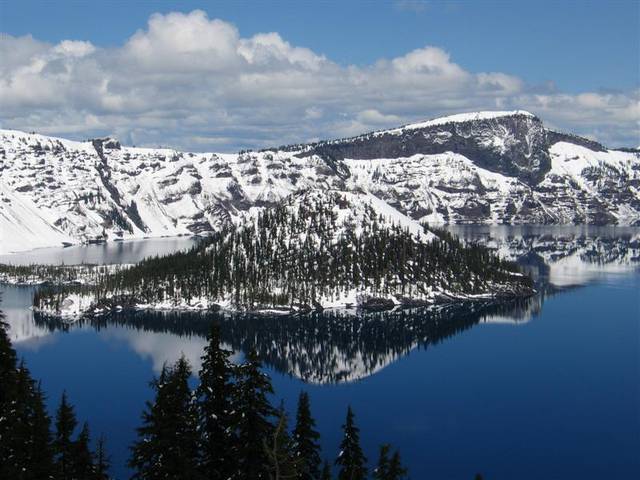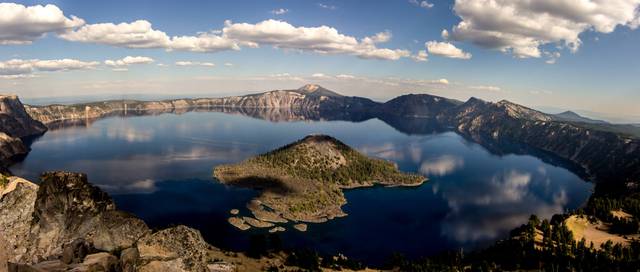Crater Lake National Park is a United States national park located in southern Oregon, in the United States. The centerpiece of the park is Crater Lake, the deepest lake in the United States, known for its deep blue color.

*Dogs and other pets are not allowed on park trails.
*Smoking is not allowed on any trail.
*Bicycling is permitted only on paved roads and the Grayback Drive.
*Feeding wild animals, including birds, is prohibited. Feeding animals is dangerous for you, bad for them, and harmful for the ecosystem.
*Stay on trails to protect vegetation and fragile hillsides. Shortcutting trails, particularly on switchbacks, can damage slopes, making them more susceptible to erosion and visual damage.
*Hiking on the caldera rim around the collapsed volcano is extremely dangerous and prohibited. People have fallen to their deaths not only by slips and falls, but from unexpected rock slides underfoot.
*Be prepared; equip yourself with water, food, warm clothing, rain gear, and anything else appropriate to the trail you take. It is better to be over-prepared than under-prepared.
*Leave all rocks, plants and artifacts undisturbed for the enjoyment of future visitors.
*Do not drink water from park streams or from the lake without properly treating it.
*Hunting is not permitted in Crater Lake National Park.

Crater Lake was formed from the collapse of Mount Mazama, a volcano in southern Oregon that once stood about 11,000 feet (3,353 m) tall. A series of destructive eruptions around 5000 BC caused the mountain's peak to collapse into its lava chamber, resulting in a caldera nearly 6 miles (9.7 km) wide. Over time, snowmelt and rain collected in the crater to form the lake, which at 1,949 feet (594 m) deep, is the deepest in the USA, 2nd in North America, and 9th in the world. Based on a comparison of average depths, however, Crater Lake at 1148 feet (350 m), is the deepest in the Western Hemisphere and third deepest in the world.
The first known white man to reach the lake was prospector John Hillman, who found the lake in 1853. Largely through the efforts of naturalist William Gladstone Steel, the United States declared Crater Lake a national park in 1902.
Crater Lake's location high in the Cascade mountains (over 7,000 feet/2,150 m above sea level) means that snow is often visible year-round. The lake is often enveloped in heavy snow during the fall, winter, and spring, forcing the closure of roads and trails. In fact, the lake averages 533 inches (1,353 cm) of snow a year. Consequently, the best time to visit Crater Lake is in the summer months, when all facilities, roads, and trails are open.
The entry fee for cars is $25 for seven days or $15 in the winter (November 1-May 21). Motorcycles $20/15. Bicycles, and pedestrians are $12 per person for seven days.
- The Pinnacles, End of Pinnacles Rd.. Can be reached in the summer from the Rim Drive on a paved, 6-mile (9.6 km) road. These eerie spires of eroded ash rise from the edges of Sand and Wheeler Creeks in pinnacle-fashion. On the way you'll pass Lost Creek Campground. Once upon a time, the road continued east of the turn-out, to the former East Entrance of the park. A path now replaces the old road and follows the rim of Sand Creek (and more views of pinnacles) to where the entrance arch still stands. A different route back to the Rim Drive, is to take the Grayback Road, a one-way, westbound only, gravel road.
- Steel Information Center, +1 541 594-3100. Apr-early Nov, 9AM-5PM. Early Nov-Apr, 10AM-4PM. Closed Christmas day. A park ranger is on duty to assist you with information, weather forecasts, backcountry camping permits, ski route advisories, and safety tips. An 18-minute film, Crater Lake: The Mirror of Heaven, is shown every half hour throughout the day in the auditorium. free.
- Rim Village Visitor Center, +1 541 594-3000. late May-Sep 9:30AM-5PM. General park information, backcountry camping permits, and educational sales items are available here. free.
- Sinnott Memorial Overlook. Jun-Sep. Exhibits on geology and lake research, and a popular view of the lake. free.
- Watchman Observation Station.
The Pinnacles, End of Pinnacles Rd.. Can be reached in the summer from the Rim Drive on a paved, 6-mile (9.6 km) road. These eerie spires of eroded ash rise from the edges of Sand and Wheeler Creeks in pinnacle-fashion. On the way you'll pass Lost Creek Campground. Once upon a time, the road continued east of the turn-out, to the former East Entrance of the park. A path now replaces the old road and follows the rim of Sand Creek (and more views of pinnacles) to where the entrance arch still stands. A different route back to the Rim Drive, is to take the Grayback Road, a one-way, westbound only, gravel road.
Steel Information Center, +1 541 594-3100. Apr-early Nov, 9AM-5PM. Early Nov-Apr, 10AM-4PM. Closed Christmas day. A park ranger is on duty to assist you with information, weather forecasts, backcountry camping permits, ski route advisories, and safety tips. An 18-minute film, Crater Lake: The Mirror of Heaven, is shown every half hour throughout the day in the auditorium. free.
Rim Village Visitor Center, +1 541 594-3000. late May-Sep 9:30AM-5PM. General park information, backcountry camping permits, and educational sales items are available here. free.
Sinnott Memorial Overlook. Jun-Sep. Exhibits on geology and lake research, and a popular view of the lake. free.
Watchman Observation Station.

- Boat tour. Only for those who are willing to hike about 15 minutes down into the crater. Access is by 1.1 mile (1.8 km) Cleetwood Trail which descends 700 feet (213 m) to the lake surface. An additional ticket will get you onto Wizard Island. Once there you can explore the island, hike to the Witches Cauldron crater, or visit Fumarole Bay. The price can be expensive but it's well worth it. $25.
- Fishing. 1/2 hour before sunrise to 1/2 hour after sunset. Season May 20 through Oct 31; however, it is legal to fish the lake year round. All waters in the park are open to fishing and no license is required. All waters are restricted to use of artificial lures and flies only. No organic bait of any kind can be used in Crater Lake National Park. This includes live or dead fish, power bait, and fish eggs or roe. The lake contains Kokanee Salmon and rainbow trout. No private boats or flotation devices are allowed. Fish must be packed out, they can not be cleaned at the lake. Streams contain Eastern, Rainbow, German Brown and Bull Trout. The streams, however, are largely inaccessible due to the steep canyons surrounding them.
- Scuba diving. Permits (no charge) are only issued from the Canfield Building (Ranger Station) in the Park Headquarters complex. A ranger will confirm your diving ability and give you specific information about diving in the lake. The lake level is at 6,173 feet in elevation, so high altitude dive tables should be used in planning your dive. Access is by Cleetwood Trail is 1.1 miles in length and descends 700 feet to the lake surface. You must be able to carry all your equipment up and down the trail. Wheeled vehicles are prohibited. Restrooms are available at the top and bottom of the Cleetwood Trail but there are no food or drinking water facilities.
- Day hiking. There are over 90 miles (145 km) of trails, with marked routes from 15 minutes to more than two hours. Hiking or climbing inside the caldera is prohibited. Conditions within the caldera are extremely dangerous. The Cleetwood Trail is the only safe and legal access to the lake’s shore.
- Bicycling. Recommended only in Jul-Sep. Paved roads only, including the 33-mile Rim Drive. Bicycling is difficult because of the steep hills and high altitudes and also because the Drive may not have shoulders and has blind curves. It is only for riders experienced with traffic.
- Ski or snowshoe. On ungroomed trails by permit only.
Boat tour. Only for those who are willing to hike about 15 minutes down into the crater. Access is by 1.1 mile (1.8 km) Cleetwood Trail which descends 700 feet (213 m) to the lake surface. An additional ticket will get you onto Wizard Island. Once there you can explore the island, hike to the Witches Cauldron crater, or visit Fumarole Bay. The price can be expensive but it's well worth it. $25.
Fishing. 1/2 hour before sunrise to 1/2 hour after sunset. Season May 20 through Oct 31; however, it is legal to fish the lake year round. All waters in the park are open to fishing and no license is required. All waters are restricted to use of artificial lures and flies only. No organic bait of any kind can be used in Crater Lake National Park. This includes live or dead fish, power bait, and fish eggs or roe. The lake contains Kokanee Salmon and rainbow trout. No private boats or flotation devices are allowed. Fish must be packed out, they can not be cleaned at the lake. Streams contain Eastern, Rainbow, German Brown and Bull Trout. The streams, however, are largely inaccessible due to the steep canyons surrounding them.
Scuba diving. Permits (no charge) are only issued from the Canfield Building (Ranger Station) in the Park Headquarters complex. A ranger will confirm your diving ability and give you specific information about diving in the lake. The lake level is at 6,173 feet in elevation, so high altitude dive tables should be used in planning your dive. Access is by Cleetwood Trail is 1.1 miles in length and descends 700 feet to the lake surface. You must be able to carry all your equipment up and down the trail. Wheeled vehicles are prohibited. Restrooms are available at the top and bottom of the Cleetwood Trail but there are no food or drinking water facilities.
Day hiking. There are over 90 miles (145 km) of trails, with marked routes from 15 minutes to more than two hours. Hiking or climbing inside the caldera is prohibited. Conditions within the caldera are extremely dangerous. The Cleetwood Trail is the only safe and legal access to the lake’s shore.
Bicycling. Recommended only in Jul-Sep. Paved roads only, including the 33-mile Rim Drive. Bicycling is difficult because of the steep hills and high altitudes and also because the Drive may not have shoulders and has blind curves. It is only for riders experienced with traffic.
Ski or snowshoe. On ungroomed trails by permit only.
While exploring keep an eye out for the gift shop that has many interesting souvenirs from paintings to postcards. You could even take home a custom carved wood sign.
- Crater Lake Lodge Dining Room, Rim Village, +1 541-594-2255 ext 3217 (reservations). May-Oct. Breakfast: 7AM-10AM, Lunch: 11:30AM-2:30PM, Dinner: 5PM-10PM. Breakfast, lunch and dinner. Spectacular views of Crater Lake. Dinner entrées emphasize the Pacific Northwest.
- Rim Village Cafe. Open daily year round (except for Thanksgiving Day and Christmas Day, December 25)..
Crater Lake Lodge Dining Room, Rim Village, +1 541-594-2255 ext 3217 (reservations). May-Oct. Breakfast: 7AM-10AM, Lunch: 11:30AM-2:30PM, Dinner: 5PM-10PM. Breakfast, lunch and dinner. Spectacular views of Crater Lake. Dinner entrées emphasize the Pacific Northwest.
Rim Village Cafe. Open daily year round (except for Thanksgiving Day and Christmas Day, December 25)..
Be aware that the waters there contain a lot of minerals and it is advised that you bring your own water with you while hiking the trails.
